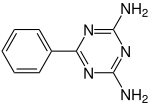Benzoguanamine
 | |
| Names | |
|---|---|
| Systematic IUPAC name
6-Phenyl-1,3,5-triazine-2,4-diamine | |
| Other names
Diamino-6-phenyl-1,3,5-triazine | |
| Identifiers | |
3D model (JSmol) |
|
| ChEMBL | |
| ChemSpider | |
| EC Number | 202-095-6 |
PubChem CID |
|
| RTECS number | XY700000 |
| UNII | |
| |
| |
| Properties | |
| C9H9N5 | |
| Molar mass | 187.21 g·mol−1 |
| Appearance | White solid |
| Density | 1.42 g cm−3 |
| Melting point | 227–228 °C (441–442 °F; 500–501 K) |
| Hazards | |
| GHS pictograms |   |
| GHS signal word | Warning |
| H302, H331, H332, H412 | |
| P261, P264, P270, P271, P273, P301+312, P304+312, P304+340, P311, P312, P321, P330, P403+233, P405, P501 | |
Except where otherwise noted, data are given for materials in their standard state (at 25 °C [77 °F], 100 kPa). | |
| Infobox references | |
Benzooguanamine is an organic compound with the chemical formula (CNH2)2(CC6H5)N3. It is related to melamine but with one amino group replaced by phenyl. Benzooguanamine is used in the manufacturing of melamine resins. Unlike melamine ((CNH2)3N3), benzoguanamine is not a crosslinker. The "benzo" prefix is historical, the compound contains phenyl, not a benzo group. A related compound is acetoguanamine.[1]
The compound is prepared by condensation of cyanoguanidine with benzonitrile.[2]
- (H2N)2C=NCN + PhCN → (CNH2)2(CPh)N3
Safety
LD50 (oral, rats) is 1470 mg/kg.
References
- ↑ H. Deim, G. Matthias, R. A. Wagner (2012). "Amino Resins". Ullmann's Encyclopedia of Industrial Chemistry. Weinheim: Wiley-VCH. doi:10.1002/14356007.a02_115.pub2.
- ↑ J. K. Simons, M. R. Saxton (1953). "Benzoguanamine". Org. Synth. 33: 13. doi:10.15227/orgsyn.033.0013.
This article is issued from
Wikipedia.
The text is licensed under Creative Commons - Attribution - Sharealike.
Additional terms may apply for the media files.